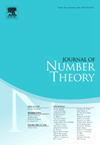Infinitude of the zeros of the Lerch zeta function on the half plane ℜ(s)>1
IF 0.7
3区 数学
Q3 MATHEMATICS
引用次数: 0
Abstract
For , the zeros of the Hurwitz zeta function have interesting features. There are no zeros in the half plane , whereas there are infinitely many zeros in the strip , provided . The existence of these infinitely many zeros was first proved by Davenport and Heilbronn for rational and transcendental values of a and then by Cassels for algebraic irrational values of a. In this article, we consider the analogous question for the zeros of the cognate Lerch zeta function , where z is a complex number of unit modulus. When z is a root of unity, the question can be answered using a theorem of Zaghloul, which is an extension of a work of Chatterjee and Gun. In the general case, we need to further extend the method of Chatterjee and Gun.
半平面上lach zeta函数零点的无穷大
对于a∈(0,1),Hurwitz zeta函数ζ(s,a):=∑n≥0(n+a)−s的零点具有有趣的特征。在半平面(≥1+a)上不存在零,而在条形(1< 1< 1+a)上存在无穷多个零,只要a≠1/2,1。首先由Davenport和Heilbronn证明了a的有理性值和超越值的无穷多个零的存在性,然后由Cassels证明了a的代数无理性值的无穷多个零的存在性。在本文中,我们考虑了近亲Lerch zeta函数ζz(s,a)的零点的类似问题:=∑n≥0zn(n+a)−s,其中z是单位模的复数。当z是单位的根时,可以用Zaghloul的定理来回答这个问题,Zaghloul定理是Chatterjee和Gun的推广。在一般情况下,我们需要进一步扩展Chatterjee和Gun的方法。
本文章由计算机程序翻译,如有差异,请以英文原文为准。
求助全文
约1分钟内获得全文
求助全文
来源期刊

Journal of Number Theory
数学-数学
CiteScore
1.30
自引率
14.30%
发文量
122
审稿时长
16 weeks
期刊介绍:
The Journal of Number Theory (JNT) features selected research articles that represent the broad spectrum of interest in contemporary number theory and allied areas. A valuable resource for mathematicians, the journal provides an international forum for the publication of original research in this field.
The Journal of Number Theory is encouraging submissions of quality, long articles where most or all of the technical details are included. The journal now considers and welcomes also papers in Computational Number Theory.
Starting in May 2019, JNT will have a new format with 3 sections:
JNT Prime targets (possibly very long with complete proofs) high impact papers. Articles published in this section will be granted 1 year promotional open access.
JNT General Section is for shorter papers. We particularly encourage submission from junior researchers. Every attempt will be made to expedite the review process for such submissions.
Computational JNT . This section aims to provide a forum to disseminate contributions which make significant use of computer calculations to derive novel number theoretic results. There will be an online repository where supplementary codes and data can be stored.
 求助内容:
求助内容: 应助结果提醒方式:
应助结果提醒方式:


